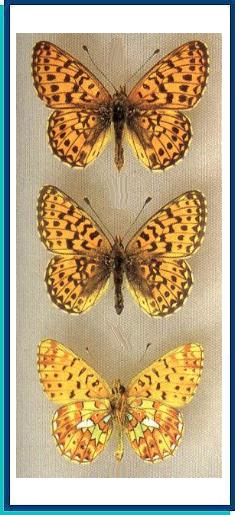LEPIDOPTERA
N Y M P H A L I D A E Swainson, 1827
CLOSSIANA Reuss, 1920
Clossiana euphrosyne (Linnaeus, 1758)
Clossiana euphrosyne (Linnaeus, 1758)

• TYPE LOCALITY. [Sweden].
• RANGE. Nearly the entire temperate belt of the Palaearctic Region except for the northern taiga and Middle Asia.
• DISTRIBUTION AND VARIATION. The nominotypical subspecies occurs in the central European part and Siberia; the other known subspecies are as follows: ssp. jingal (Herbst, 1804) (N. European part and Siberia); ssp. rusalka (Fruhstorfer, 1909) (S. European part and W. Siberia); ssp. orphana (Fruhstorfer, 1907) (Transbaikalia, Amur and Ussuri regions); ssp. kamtschadalus (Seitz, [1909]) (described from Kamchatka); ssp. umbra (Seitz, [1909]) (Altai and Sayan mts.); ssp. dagestani-ca (Sovinsky, 1905) (= anka (Fruhstorfer, 1907); = phaenea (Jachontov, 1908)) (Caucasus and Transcaucasia). Except for dagestanica, all of these subspecies are superficially very similar to the nominotypical one.
• HABITATS AND BIOLOGY. Open landscapes in the forest and forest-steppe zones, mountain meadows up to 2,000 m a.s.l. Flight period: May to August, sometimes in two generations. Host plants in Europe (Lang, 1884; Seppanen, 1970): Viola canina, Rubus, Fragaria, Vaccinium uliginosum, Ledum pdlustre; in Siberia (Novomodnyi, 1996): Viola hirta; in the Amur region (Novomodnyi, 1996): Waldsteinia ternata.
• SIMILAR SPECIES. Clossiana iphigenia: mother-of-pearl spot at base of UNH absent. C. selene, C. perryi: discal band of UNH with three mother-of-pearl spots. C. oscarus. C. thore: discal band of UNH without mother-of-pearl spots.
Photo and text: Guide to the BUTTERFLIES OF RUSSIA and adjacent territories Volume 2. PENSOFT, Sofia - Moscow. 2000